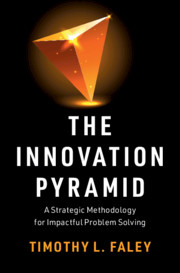Book contents
- The Innovation Pyramid
- The Innovation Pyramid
- Copyright page
- Dedication
- Contents
- Figures
- 1 Introduction
- Part I Innovation Design and Execution
- Part II The Diverge–Organize–Converge Process
- 8 Diverge–Organize–Converge Process Overview
- 9 Diverge
- 10 Organize
- 11 Converge
- 12 Book Summary
- Book part
- Bibliography
- Index
11 - Converge
from Part II - The Diverge–Organize–Converge Process
Published online by Cambridge University Press: 30 December 2020
- The Innovation Pyramid
- The Innovation Pyramid
- Copyright page
- Dedication
- Contents
- Figures
- 1 Introduction
- Part I Innovation Design and Execution
- Part II The Diverge–Organize–Converge Process
- 8 Diverge–Organize–Converge Process Overview
- 9 Diverge
- 10 Organize
- 11 Converge
- 12 Book Summary
- Book part
- Bibliography
- Index
Summary
Convergent thinking is the third and final step of the DOC Process. The aim of the Converge step is to narrow the organized group of information down to a single choice, the “best” choice. In order to choose the “best” factor of the General Problem to address, or select the “best” solution to that problem, we need to first define “best.” That criteria must be clear, concious and public. We do not want to make intuitive, visceral decisions, but rather conscious, rational and reasonable ones. In order to accomplish that desired outcome, we need to choose a complete set of selection criteria.
Before applying the criteria, we need to create a level evaluation field for all concepts that will be judged by ensuring that all the organized concepts are described in enough detail, with respect to the criteria, to ensure they can compete equally against each other. This may mean returning to the Organize step once the convergent criteria are set. Generic criteria for Problem Identification and Solution Formulation are offered in this chapter. Selection tools ranging from t-charts to paired comparative analysis are also described.
- Type
- Chapter
- Information
- The Innovation PyramidA Strategic Methodology for Impactful Problem Solving, pp. 199 - 213Publisher: Cambridge University PressPrint publication year: 2021

